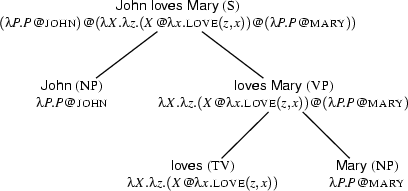3.4.5 Advanced Topics: Proper Names and Transitive Verbs
Complex cases for
-based semantic construction: Proper names any transitive verbs require role-reversion.
It looks as if there are clouds on the horizon. For example, while the semantic representation of a quantifying NP such as ``a woman'' can be used as a functor, surely the semantic representation of an NP like ``John'' will have to be used as an argument. Will this problem throw a spanner in the works of our new semantic construction mechanism?
Proper names
In fact, there's no problem at all - if we only look at things the right way. We want to use proper names as functors, the same way as quantified noun phrases. So let's simply keep this intended use in mind when designing the semantic representations for proper names. It then all becomes a matter of abstracting cleverly. Indeed the  -calculus offers a delightfully simple functorial representation for proper names, as the following examples show:
-calculus offers a delightfully simple functorial representation for proper names, as the following examples show:
``Mary'': 
``John'': 
Role-Reversing
From outside (i.e. if we only look at the  -prefix) these representations are exactly like the ones for quantified noun phrases. They are abstractions, thus they can be used as functors in the same way. However looking at the inside, note what such functors do. They are essentially instructions to substitute their argument in P (Q), which amounts to applying their own arguments to themselves! Because the
-prefix) these representations are exactly like the ones for quantified noun phrases. They are abstractions, thus they can be used as functors in the same way. However looking at the inside, note what such functors do. They are essentially instructions to substitute their argument in P (Q), which amounts to applying their own arguments to themselves! Because the  -calculus offers us the means to specify such role-reversing functors, proper names can be used as functors just like quantified NPs.
-calculus offers us the means to specify such role-reversing functors, proper names can be used as functors just like quantified NPs.
Transitive verbs
As an example of these new representations in action, let us build a representation for ``John loves Mary''. But before we can do so, we have to meet another challenge: ``loves'' is a transitive verb, it takes an object and forms a VP. We will want to apply it to its object-NP. And the resulting VP should be usable just like a standard intransitive verb, we want to be able to apply the subject NP to it. This is what we know in advance.
Given these requirements, a  -expression like the simple
-expression like the simple  (which we've seen in Section 3.4.1) surely won't do. After all the object NP combining with a transitive verb is itself a functor. It would be inserted for
(which we've seen in Section 3.4.1) surely won't do. After all the object NP combining with a transitive verb is itself a functor. It would be inserted for  in this
in this  -expression, but
-expression, but  isn't applied to anything anywhere. So the result could never be
isn't applied to anything anywhere. So the result could never be  -reduced to a well-formed first-order formula. How do we make our representation fit our needs this time? Let's try something like our role-reversing trick again; we'll assign ``loves'' the following
-reduced to a well-formed first-order formula. How do we make our representation fit our needs this time? Let's try something like our role-reversing trick again; we'll assign ``loves'' the following  -expression:
-expression:
 .
.
An example
Thus prepared we're now ready to have a look at the semantic construction for ``John loves Mary''. We can build the following tree:

How is this going to work? Let's look at the application at the S-node, and think through step by step what happens when we  -convert it: Inside our complex application, the representation for the object NP is substituted for
-convert it: Inside our complex application, the representation for the object NP is substituted for  . It ends up being applied to something looking like an intransitive verb (namely to
. It ends up being applied to something looking like an intransitive verb (namely to  ). This application is going to be no problem - it's structurally the same we would get if our object NP was the subject of an intransitive verb. So everything is fine here.
). This application is going to be no problem - it's structurally the same we would get if our object NP was the subject of an intransitive verb. So everything is fine here.
Now the remaining prefix  makes the complete VP-representation also function like that of an intransitive verb (from outside). And indeed the subject NP semantic representation finally takes the VP semantic representation as argument, as if it was the representation of an intransitive verb. So everything is fine here, too.
makes the complete VP-representation also function like that of an intransitive verb (from outside). And indeed the subject NP semantic representation finally takes the VP semantic representation as argument, as if it was the representation of an intransitive verb. So everything is fine here, too.
Trace the semantic construction!
Make sure you understand what is going on here by  -reducing the expression at the S-node yourself!
-reducing the expression at the S-node yourself!